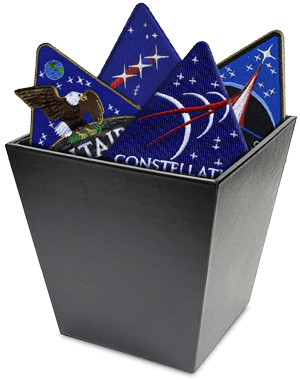
If you’re an OWC customer, you likely own an OWC Mercury drive…whether it be an optical or hard disk drive solution….or a high-performance SSD. As the theme of this post is a closer look at Mercury (the planet), I thought I’d first give you a little history on how the name Mercury was chosen for our drive line…then blast off into the really cool space stuff.
As you may remember from past posts about space related topics, our founder and CEO, Larry O’Connor started what you know today as OWC back in 1988. Its first branded product was a processor upgrade called the OWC Rocket. In 2000, the Mercury Classic Elite was born. And then nearly every year since, we’ve come up with another drive under that banner name. Larry has always been fascinated by all things space related and when I asked him how he chose Mercury for our drive line, he said it “was a combination of aspects….the Roman God who was known for speed, the NASA program which launched the first Americans into space, and the uniqueness of the planet itself.”
Speaking of the planet’s uniqueness, were you aware that this Thursday you’ll have a first-of-its-kind opportunity to see it up close? Really close?
How does 125 miles away from a surface that can heat up to 800°F when facing the sun grab ya? Hopefully, there’s a happy medium somewhere; on the opposite side, it can dip down to -300°F.
Not to worry though; providing you this closer-than-ever-before-available look is a NASA probe called Messenger—which stands for MErcury Surface, Space ENvironment, GEochemistry, and Ranging.
The purpose of the mission is to enable scientists to better understand how Mercury was formed, how it evolved, and how it generated its magnetic field. More to the point, scientists have six key questions on the second most dense planet in our solar system.
Now before you launch into the mission, and perhaps even interact with NASA on it via live chat (see info at end of post), here’s my CliffsNotes take on what you should know about Mercury, Messenger, and why this information matters:
- Mercury is one of the five brightest objects in the sky, outshining all the stars except Sirius. Only the sun, moon, Venus, and Jupiter are brighter.
- Many astronomers have never seen Mercury because it’s the closest planet to the sun, thus it is only barely visible just after sunset or just before sunrise.
- Mercury has been called an ‘extreme’ planet because it’s the smallest, the densest, has the oldest surface, its surface temperature has the most variance, and it is the least explored.
- The Messenger satellite will be the first spacecraft ever to orbit Mercury. The probe, which has already flown past the planet three times, will fire its thrusters this Thursday so it can enter the planet’s orbit to begin a year long data gathering mission.
- When it enters Mercury’s orbit, Messenger will be 96.35 million miles from Earth.
- Messenger’s mission will last one Earth year. Because Mercury rotates on its axis so slowly — just once every 176 Earth days — Messenger’s mission covers just two Mercury days.
- This mission will generate the first new data about Mercury since the Mariner 10 mission over 30 years ago.
- The $446 million Messenger spacecraft launched in August 2004. Since then, it has taken a 4.9 billion-mile route through the inner solar system….which has passed by Earth once, Venus twice, and past Mercury three times.
- The Johns Hopkins University Applied Physics Laboratory built and operates the Messenger spacecraft and manages this Discovery-class mission for NASA.
Have more questions on the mission? No problem, you can participate in a live chat on Wednesday, Mar. 16, from 10-11 a.m. EDT, with Jimmy Lee, Messenger mission manager, and Mike Galuska, chief engineer of the Discovery, New Frontiers and Lunar Quest Program Office.








